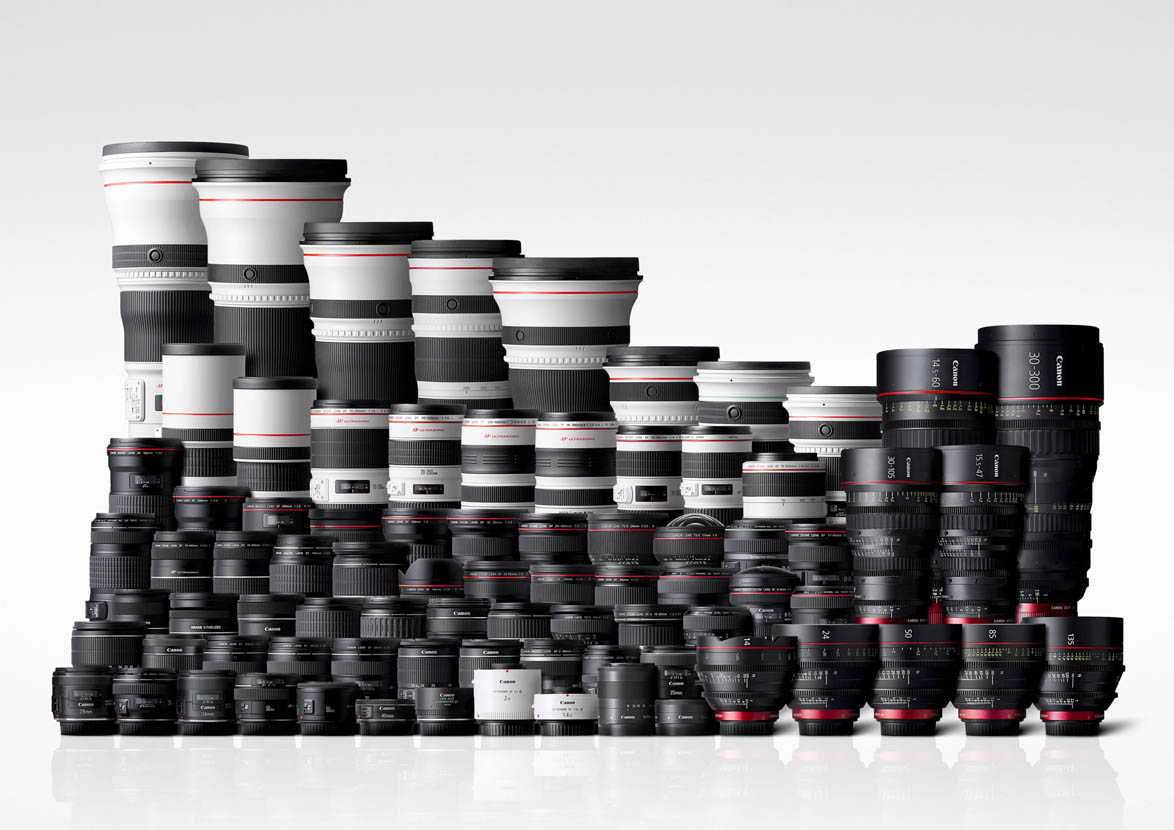I get asked the above question quite often – only “which camera do you recommend?” being more popular.
Well, this piece isn’t the all too familiar “this is the best lens you must own, and here’s a link to buy it – which earns me a small commission” type. I’m not going to recommend any single lens here. But I will give you some tips on how to get an answer for this question from the only authentic source – yourself.
With freedom comes responsibility
The sheer amount of lenses available for a single mount could be overwhelming. For example Canon offers no less than 76 EF/EF-S lenses at the time of writing. And this does not include 3rd party offers from other manufacturers like Sigma and Zeiss.

The Canon lens lineup at the time of manufacturing the 100 millionth lens. Image courtesy of Canon.
There is a popular – but false – wisdom that you should cover every possible focal length. Just in case you need it. I must admit that as a newbie I fell into this trap too…
But why this trap exists in the first place? Because going this way is easy. It’s pretty damn easy to pick up two or three quality zooms and be “covered”. I’m not saying that zooms are inherently bad. There are situations (when your movement is restricted and/or you can’t change lenses) when they are indispensable. I’m just saying that picking up zooms on the idea of being “covered” is a bad method of choice.
Also zooms are great for my mom, but if you are serious about photography then you should be serious about angle of view – and thus lens – choice. That is, you should make informed decisions about the lenses you use. No, you shouldn’t trust and rely on information coming from the outside (blogs, friends, etc). You must check and evaluate your own work and yourself continuously and correct the mistakes along the way. Believe me, you will make lots of mistakes – but those will teach unforgettable lessons about your vision and your personality.
The goal is to find the glass that matches you vision. Both in angle of view and character. Yes, you’ll need to work and experiment a lot. But it will be fun!
Matchmaking tips
The following is a list of tips and techniques I found incredibly useful in evaluating my own work and vision. Chances are that they will also help you.
Borrow or rent. You have to see it yourself. You can’t trust reviews on the net. So instead of buying a given lens (which may or may not fit your vision) it is more economical to borrow one from a friend or rent it. But more important is to do some real work with it! Brick walls and pets doesn’t count (unless what moves your world is either brick walls or pets, of course). Use the lens for a handful of shoots. But do it at least in two sets, a few weeks apart. Evaluating the resulting images on the camera’s LCD also doesn’t count. Process them. Print them. Use them as you normally would use any of your images. If you can’t make a single good image with the lens, then it doesn’t match your vision, so it’s better to let the given focal length go. If you think that usability, max aperture, or any other aspect sucks, then look for an alternative with the desired parameters.
Simulate. Especially useful when you can’t borrow or rent a lens, or for first quick checks. If you have an iPhone/iPad/iPod, my Artist’s Viewfinder app lets you simulate viewing angles for tons of different camera and lens combinations. Or you can tape down the zoom ring on your existing zoom to simulate what it feels like to shoot with a prime. Or crop a wider image in Photoshop. With simulation you can get a feel, but don’t forget that it’s not the real thing. You should have the lens in hand to do a final check whether you match or not.
Check your existing work. This is a pretty powerful thing. As metadata in digital images record the focal length they were shot with, you can check your previous images whether you like or dislike a given focal length. Only finished work counts, however. You will have countless images with any given lens classified as crap. Don’t let them deteriorate the results. Also don’t forget to account for format differences! In my case, digging in Lightroom’s database revealed a (then) surprising fact: even if I used zooms, all my finished landscape images were clustered around three major focal lengths: 24, 50 and 135 mm (in full frame 35mm terms). It’s not a surprise now (four years later) that these are the focal lengths I always carry.
Buy the best you can afford. Great lenses will be with you for 10-20 years, or even more. They also tend to keep their value. But most importantly, they match your vision and style, and thus are vital to your work. Do yourself a favor and don’t be cheap! You’ll be grateful 20 years later…





